
Isopoda is an order of crustaceans that includes woodlice and their relatives. Isopods live in the sea, in fresh water, or on land. All have rigid, segmented exoskeletons, two pairs of antennae, seven pairs of jointed limbs on the thorax, and five pairs of branching appendages on the abdomen that are used in respiration. Females brood their young in a pouch under their thorax.
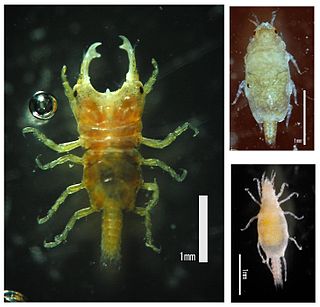
The Gnathiidae are a family of isopod crustaceans. They occur in a wide range of depths, from the littoral zone to the deep sea. The adults are associated with sponges and may not feed. The juvenile form is known as a 'praniza', and it is a temporary parasite of marine fish. These forms are not larvae; Gnathiidae instead become parasitic during the manca stage. Mancae of the Gnathiidae closely resemble the adult form, however they lack the final pair of pereiopods.
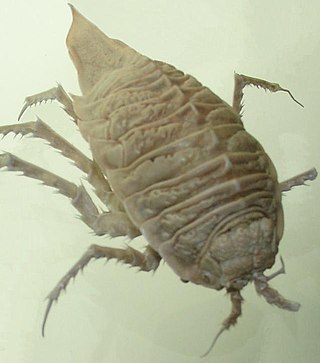
The Valvifera are marine isopod crustaceans. Valviferans are distinguished, however, by the flat, valve-like uropods which hinge laterally and fold inward beneath the rear part of their bodies, covering the pleopods. Some species are omnivorous, and serve as effective scavengers in the economy of the sea.

Sphaeromatidae is a family of isopods, often encountered on rocky shores and in shelf waters in temperate zones. The family includes almost 100 genera and 619 known marine species. Within these genera, there are groups that share distinctive morphologies; further research may reclassify these genus-groups as separate families.
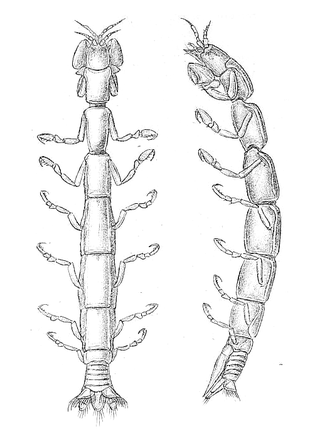
Anthuroidea is a superfamily of isopod crustaceans, formerly treated as a suborder, Anthuridea. The group is characterised by "an elongate cylindrical body form, without dorsal coxal plates, and with a uropodal exopod attached to the peduncle proximally and dorsally". There are more than 500 described species in 57 genera, arranged across six families:

Pentidotea wosnesenskii is a marine isopod which lives on seaweed on rocky shores along the British Columbia and Washington coastlines, as far south as San Francisco. It can often be found hiding under rockweed in the intertidal zone, and can be found in depths up to 919 metres (3,015 ft). It was described as Idotea wosnesenskii in 1851, by Johann Friedrich von Brandt, and is named after the Russian biologist Ilya G. Voznesensky. The isopod grows up to 4 centimetres in length and is usually green in colour.

The Asellidae are a family of isopod crustaceans, one of the largest families of freshwater isopods, living in both epigean and hypogean habitats in North America and Europe.

The Idoteidae are a family of isopod crustaceans. It includes these genera:

The Leptanthuridae are a family of isopod crustaceans, containing the following genera:

Cymothoida is the name of a suborder of isopod crustaceans with a mostly carnivorous or parasitic lifestyle. It contains more than 2,700 described species in four superfamilies. Members of the suborder are characterised by their specialised mouthparts which include a mandible with a tooth-like process which is adapted for cutting or slicing.

Sphaeromatidea is a suborder of isopod crustaceans.

The Chaetiliidae are a family of isopod crustaceans in the suborder Valvifera, comprising these genera:
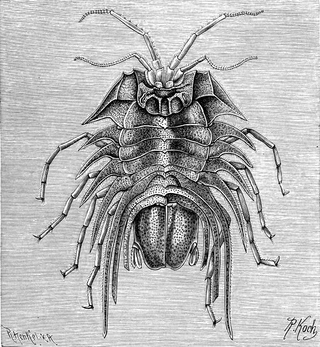
Serolidae is a family of isopod crustaceans, containing the following genera :
Porcellionides cilicius is a woodlouse that can be found on Cyprus and in Turkey. The species have one subspecies Porcellionides cilicius antiochensis that can be found only on Cyprus.
Saduria sibirica is a benthic isopod crustacean of the family Chaetiliidae. It is widespread in Arctic marine water near the coasts of Siberia.
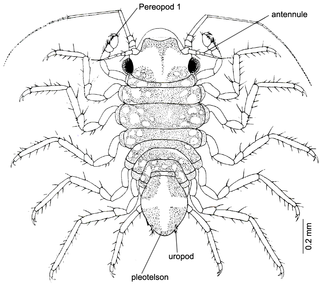
The Munnidae are a family of isopod crustaceans, containing these genera:
Euidotea durvillei, known commonly as the red seaweed isopod, is a species of marine isopod found in New Zealand.
Euidotea is a genus of marine isopods belonging to the family Idoteidae. The species of this genus are found in Australia and New Zealand.
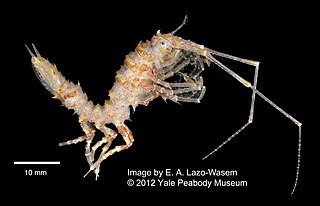
Antarcturidae is a family of marine isopods belonging to the suborder Valvifera.
Holidoteidae is a family of marine isopods belonging to the suborder Valvifera.










